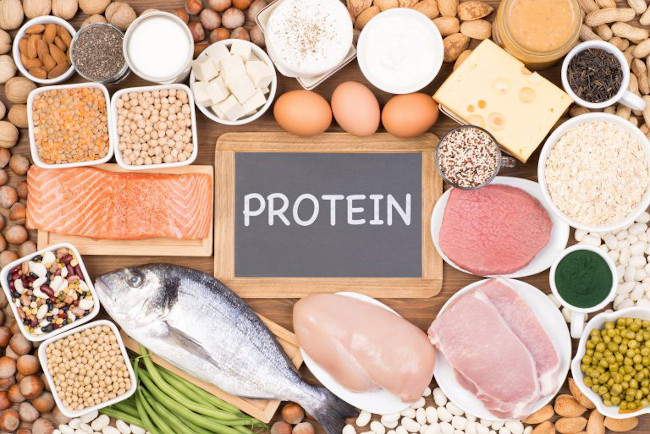Protein, what is it, why do we need it, how often should we consume it and what kinds of foods and recipes should we be considering?
In this article we shed some light on the shadows of protein ingestion. We discuss what proteins are, the differences between essential and non-essential amino acids and complete and incomplete proteins. We also outline some valuable factors to consider when trying to achieve optimal daily protein targets, otherwise known as the 3T’s (type, timing and total). As a bonus, we have also prepared some recipe suggestions to spice up your daily meal choices, which have been adapted by TORQ to deliver precisely the right amount of protein to support your athletic development.
Proteins & Amino Acids: Protein is a nutrient consumed within the food we eat and is responsible for building our physical human structure as well as controlling how the cells within our body function. Without proteins we wouldn’t be able to grow, develop or function. The human body is made up of tens of thousands of different proteins that make up who we are. From skin, hair, tendons and muscle tissue, to the enzymes that breakdown our food, and the hormones that control blood glucose such as insulin, each protein has a specific function.
Interestingly, proteins do not start their life as proteins, they are made up from a collection of amino acids. If we use the analogy of a house, a protein would be considered a fully built house, functional and strong, yet there are many individual components that have been used to build the house, such as bricks, mortar, timber, roofing slates etc. It’s these individual components that make up a house that are analogous to the amino acids that make up a protein.
Amino acids are a fundamental component of protein production (protein synthesis). Twenty amino acids make up every single protein and simply the order in which these twenty amino acids are joined together will coordinate the function of the protein being produced. Using the house example, the same bricks could be aligned to create a semi-detached house or a hospital, both of which have a different purpose. Of the 20 amino acids that exist, 9 are considered essential, whilst others are considered non-essential. Although all amino acids are essential to build proteins, some are considered ‘essential amino acids’ as we have to source them from our diet, while others can be manufactured by the human body and are therefore considered ‘non-essential.’
| Essential Amino Acids | Non Essential Amino Acids |
|---|---|
| Histidine | Alanine |
| Isoleucine | Arginine |
| Leucine | Asparagine |
| Lysine | Aspartic Acid |
| Methionine | Cysteine |
| Phenylalanine | Glutamic Acid |
| Threonine | Glutamine |
| Tryptophan | Glycine |
| Valine | Proline |
| Serine | |
| Tyrosine |
By understanding that both non-essential and essential amino acids are required to produce new proteins, without the essential amino acids, certain vital functional proteins can’t be built. We can see that consuming a diet that includes all of the essential amino acids is incredibly important. Some protein sources are considered ‘complete proteins’ while others are considered ‘incomplete’. Complete proteins contain all of the essential amino acids, while incomplete proteins are missing some of them. For people who eat regular sources of poultry, fish, red meat, eggs and dairy products will find that they will rarely under-consume the daily targets for essential amino acids, however those who are vegan, or vegetarian may find that without careful attention to their diets, some meals can fall short. Fortunately, there’s a very simple rule for you to remember if you are following a plant-based diet, which is that you need to mix your pulses and grains. Examples of pulses are things like beans, peas and lentils. Grains include all of the cereals like wheat, maize and rice and include cereal products like bread and pasta. Beans on toast is the classic ‘complete protein’ plant-based meal, because it mixes pulses (beans) with grains (bread).
Some plant-based protein sources like quinoa, hempseed and buckwheat are nearly complete proteins and therefore could form a staple part of your daily protein consumption to help reach the daily recommended targets. Other plant-based foods are fortified into complete proteins, such as fortified soy, which is often used as a meat substitute and this can help make dietary planning simpler. At TORQ, through our Fitness Consultancy we have always recommended that athletes aim to consume more pulses, because they can incidentally gain the essential amino acids from cereal products as they are so widely consumed, so getting them to focus on the pulses in their diets simultaneously addresses the complete protein issue and delivers high levels of carbohydrate – the essential fuel for endurance exercise.
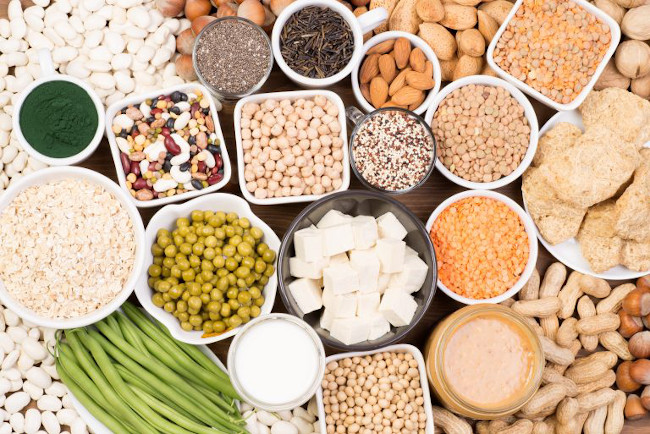
Protein Turnover: Unlike fats and carbohydrate which can be stored within the tissues of the body for use when required, protein in the form of muscle, hormones, enzymes and other bodily tissues are constantly being produced and broken down in a process known as protein turnover. The lifespan of specific proteins differs based upon their function and the demands placed upon them.
The body houses ‘free amino acids pools’ which are essentially very small holding pens of free, unbound amino acids, which can be drawn upon to create new amino acids chains and these are later formed into functional proteins such as muscle tissue. However, these free amino acid pools are exceptionally small and cannot cope with the demand for continual protein production, which is why we also experience protein degradation – the break-down of old or damaged proteins to top up the free amino acid pools preventing their entire depletion. We can however manipulate the rate protein is both produced and broken down by exercising, which stimulates both protein production and breakdown, and by eating protein in our diet, which solely stimulates protein production.
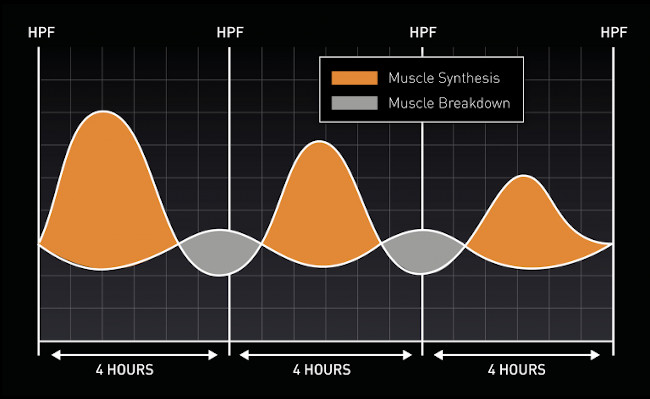
The diagram above highlights the concept of protein turnover. The orange peaks denote periods of new protein production. It is during these phases where new proteins are being built, allowing repair from stress factors such as exercise. Ultimately it is within these periods where positive adaptations to training occur. These adaptations could be aerobic adaptations (mitochondrial biogenesis – the production of new mitochondria within the cells which help with aerobic power production) or anaerobic adaptations (muscular hypertrophy – the growth of new muscle fibres and strength as a result of resistance/power training). However, you will notice that these peaks are not permanent, and if protein within the diet is not consumed within 3–4 hours, protein production turns to breakdown as the free amino acid pools start to become depleted and this is denoted by the grey areas. This is not desirable as the proteins we have worked so hard to produce start to break down.
‘HPF’ on the graph above refers to ‘High Protein Feed’ and to ensure these periods of protein breakdown are as short as possible, we must consume another 20-25g of protein within 3-4 hours of the previous high protein feed. This will re-stimulate protein production and allow new proteins to be produced and positive training adaptations to continue. The key here is to achieve what is known as a “positive net protein balance” where the rate of protein production is greater than the rate of breakdown.
Does the Protein Source Affect Protein Production Rates? In short, yes. As we have already established above, foods which are complete with all essential amino acids will provide all of the materials required to build new proteins. As athletes and physically active people, our goal is to maximise our “bang for buck” and within the narrative of protein production, consuming foods rich in Branched Chain Amino Acids (BCAA’s) will increase the peak of protein production, meaning that more proteins can be produced within the same time frame. There are 3 BCAA’s, leucine, iso-leucine and valine. These 3 BCAA’s have been shown to increase stimulation of protein production and therefore lead to a better training recovery and adaptation response.
BCAA’s are also essential amino acids and foods typically rich in them include fish, chicken, red meat, eggs and milk to name a few – in essence, foods that also contain their full complement of essential amino acids. Furthermore, high quantities of BCAA’s can also be consumed in a concentrated form, ideally via Whey Protein Concentrate or Pea Protein Isolate if you are vegan or want the best plant-based protein source. As well as TORQ offering concentrated (80%) protein sources of whey and pea protein, we also now offer two BCAA-rich food sources. Our high protein pastas (60% protein) include High Protein Fusilli (pasta twists) and High Protein Orzo (similar size and texture to rice) and can be used to transform vegetarian recipes by adding a high quality protein source. A little further on, we give you some recipe ideas, but the limit really is your imagination, because it’s easy to simply switch some of your regular pasta or rice with TORQ Fusilli or TORQ Orzo respectively to help you achieve your regular 20-25g protein goals.

Type, Timing & Total of Protein Feeding (3 T’s): When adopting any sports nutrition regime, the fundamentals of the 3T’s should be considered – Type, Timing and Total. If the 3 T’s are planned correctly, the total amount of calories consumed from a high protein meal should slightly exceed the expenditure, allowing for maintenance of optimal body weight, yet achieving the positive net balance discussed earlier. The type of protein consumed in the form of whole foods or supplements should explore the rate of digestion, especially surrounding the pre, during and post exercise window. And last but certainly not least, the timing of protein ingestion is significantly important to the management of gastric comfort, optimal recovery and adaptation.
Type: We have already established that high quality proteins containing all of the essential amino acids are most desirable (or mixtures of protein sources that provide all of the essential amino acids). In addition there are a number of different factors to consider, for example, density and rate of absorption of the protein source, ethical, moral or religious considerations and also flavour and personal preference. With regard to the rate of absorption of a particular protein source, this is linked to the timing of consumption outlined below. Pre or immediately post workout, you will need a ‘type’ of protein that is readily absorbed and realistically, this refers to the type of food as much as the type of protein. A lean whey protein-based drink like TORQ Recovery Drink will be much easier to absorb than the same whey protein content enveloped in fat via a creamy luxury yoghurt. Fat is the enemy when it comes to nutrient absorption, so if you want to get something into your body quickly, make sure the overall fat content is low. Whey is certainly the best protein to consume in these circumstances regardless, but be mindful of what else it comes with.
At other times, meat and fish contain all the essential amino acids and are therefore hugely relevant as components of a balanced nutritional recipe. However, from an ethical/moral/religious perspective, many people may choose to avoid meat and vegetarianism and particularly veganism are on the rise. We have highlighted some high quality vegetarian and plant-based protein foods below:
| Vegetarian Protein Sources | |||
|---|---|---|---|
| Tofu | Quorn | Soya | |
| Eggs | Milk | Cheese | |
| Greek Yoghurt | Hummus | Nuts | |
| Peanut Butter | Tahini | Seeds | |
| Chick Peas | Kidney Beans | Lentils | |
| Protein Pasta | Protein Orzo | Protein Crisps | |
| Recovery Drinks | SNAQ Meals | SNAQ Breakfasts | |
| Whey Protein Concentrate | Pea Protein Isolate |
Timing: As well as ensuring that 20-25g of protein is consumed every 3-4 hours, you will also need to fit the timing of your workouts around your protein feeds or vice versa. The findings from years of peer reviewed research have highlighted that consuming protein immediately after exercise is optimal from the perspective of enhancing recovery, adaptation and protein production. TORQ Recovery Drink contains 20-25g of high quality whey protein and TORQ Vegan Recovery Drink contains 20-25g of high quality pea protein. Either of these should be consumed immediately after exercise, because the co-ingestion of carbohydrate and protein immediately after exercise has been found to produce benefits beyond the protein mechanics alone. The protein actually helps to stimulate the storage of carbohydrate as glycogen after exercise, further enhancing the recovery process.
Working backwards from the end of your workout, your previous protein feed should have been 4 hours earlier. For a workout of up to 2 hours, the logistics are easy, for longer workouts, you will need to ensure that your pre-workout protein feed is low in fat and easily digested, or it could a) cause indigestion or cramping and/or b) affect your ability to absorb carbohydrate, which is not desirable if you’re needing to fuel an important workout. If your workouts are especially long, you may even want to consider a lean protein feed during a workout. Typically we wouldn’t encourage this for one-off lengthy workouts – you can afford to miss a protein feed, but if you have extensive sessions planned on consecutive days, like during a stage race or on a training camp, it’s wise to work protein intake into your overall strategy. We talk about this in practical terms in our Multi-Day Event Nutrition resource, so click HERE to understand this in greater detail.
Daily protein ingestion targets outside of the exercise window have already been explored when we were discussing protein turnover, however the infographic below summarises the process quite nicely. We have deliberately varied the spacing between feeds as in reality timing can never be perfect, not that you shouldn’t aim for it to be! Try to get your spacing as close to 4-hourly as possible.
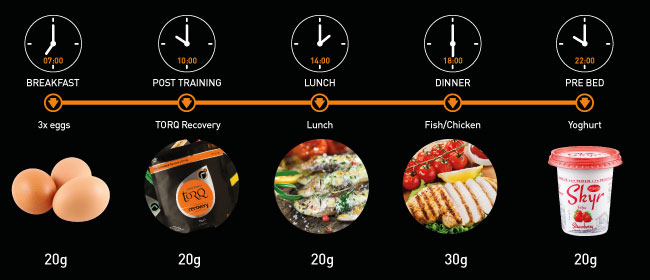
Total: For general non-athletic populations, a target recommendation of protein is calculated at 0.8g/kg of body weight, which for a standard 80kg person would work out at 64g of protein per day. However, this dietary recommendation is based upon a typically low daily energy expenditure along with infrequent and low intensity exercise such as walking etc. If your aim is to progress your fitness and drive your performance forward, you should be looking to consume more protein. We know that protein is one of the key components required for recovery and adaptation, so it stands to reason that if you exercise more regularly, you will generate an increase in protein turnover. Research has explored the increased protein requirements for well trained and athletic populations and the findings have concluded a necessity for athletes to consume 50 – 100% more protein per day than more sedentary/less athletic people. Guidelines point in the direction of a daily protein intake of 1.2 – 1.6g/kg and for the same 80kg person would equate to 96 – 128 grams of protein respectively. Power athletes or larger individuals with greater muscle mass tend to have a the highest protein turnover, so should look to consume protein towards the upper end of this range and endurance athletes or smaller individuals towards the lower end.
If we refer back to the diagram above, we have already suggested 4 X 20g protein feeds and 1 X 30g feed, which equals 110g total daily protein intake. 5 X 25g protein feeds would deliver 125g total daily protein intake, so as you’re probably a TORQ customer interested in progressing your endurance performance, we would recommend around 5 X 20g protein serves per day if you’re under 80kg and 5 X 25g serves if you’re over 80Kg. Of course a good rule of thumb is simply to aim for the ballpark of 20-25g protein per serve unless you’re planning on weighing everything meticulously.
Protein Meals & Snacks: We’ve covered the theory, so in practical terms, how do you achieve 20-25g of high quality protein intake every 3-4 hours? An approach we really support at TORQ is to move away from the traditional ‘3 square meals per day’ mindset. Typically, this encourages gorging on calories, over-consumption of protein during these times and big gaps in protein intake, which we know to be ineffective. Try to spread your calorie intake out over the day, ensuring you’re hitting your protein targets within the golden 3-4 hours. These don’t have to be equally-sized calorie feeds as such, so you can still maintain some shape to your day with breakfast, lunch and dinner, but the protein content does need to be roughly equal on each feed.
This logic translates into our TORQ SNAQ range of products where we’ve created a variety of meals and breakfasts all containing the magic 25g of high quality protein, yet we’ve manipulated the carbohydrate (overall calorie) content between them to fit in with the level of activity you’re doing. For instance, this week might be a rest week, so although you’ll need your regular protein intake, your need for carbohydrate calories will need to be relatively modest. Or perhaps you had a lot of calories at breakfast and you don’t need so many mid morning. In both of these situations you could consume a SNAQ 2:1 Breakfast or Meal (2:1 means 2 parts carbohydrate to 1 part protein). It’s a small snack serving that gives you your 25g of protein. The SNAQ 3:1 Breakfasts and Meals provide more carbohydrate and the SNAQ 5:1 Breakfasts and Meals contain even more calories and are quite a substantial sized portion. These different ratio products give you the flexibility to choose an appropriately sized feed.
These SNAQ Breakfasts and Meals are a handy ‘tool for the job’ but one can’t survive on TORQ alone! The table below gives you an indication of what 20g of high quality protein looks like and towards the end of this article we share some delicious 20-25g protein recipes with you too. For 25g of protein, multiply the portion size below by 1.25:
| Portion Size | Protein | Food |
|---|---|---|
| 83g | 20g | Chicken Breast |
| 103g | 20g | Minced Beef |
| 80g | 20g | Tuna (tinned in spring water) |
| 166g | 20g | Cod Fillet |
| 95g | 20g | Salmon |
| 125g | 20g | Ham |
| 160 | 20g | Tofu |
| 133g | 20g | Quorn |
| 208g | 20g | Cottage Cheese |
| 190g | 20g | Greek Yoghurt (0% fat) |
| x3 | 20g | Whole Eggs |
Table data from MyFitnessPal
It shouldn’t require a huge amount of imagination to work these high quality protein foods into some tasty recipes.
More than ever, there are a huge variety of protein-based snacks on the market now, so experiment with a few. Just make sure that they contain 20-25g of high quality protein, ideally whey, or pea if you’re vegan. Be careful of the fat content, because some of these snacks can be more calorific than you’d think. Also, be aware that sweet low carb/high protein snacks will contain artificial sweeteners. At TORQ, we do not agree with their use as effects on health long term are questionable.
If you’re vegan, organising your 20-25g high quality protein feeds is significantly more difficult, although certainly not impossible – you will need to be organised. It’s not necessarily the task of finding protein per se, it’s ensuring that your serving has all of the essential amino acids and can therefore form complete proteins within the body. If you’re a committed vegan, you will know exactly what you’re doing and how to achieve it, but don’t forget the athlete’s friend ‘beans on toast’.
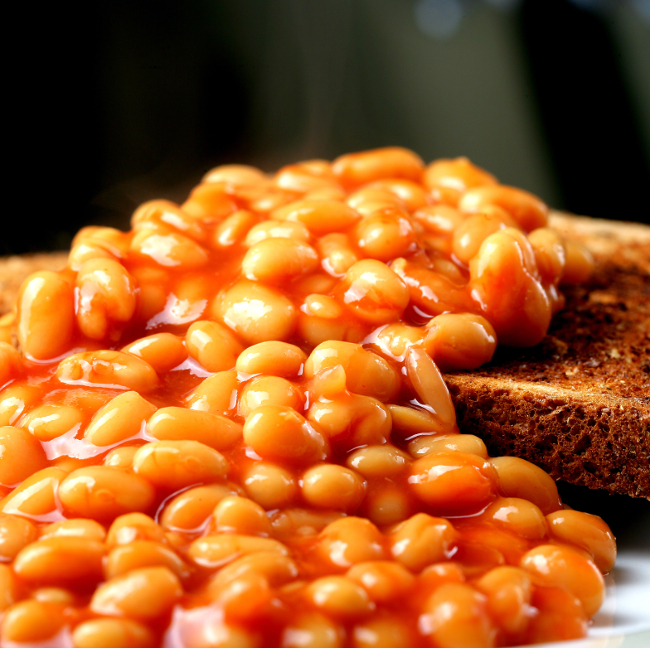
As we mentioned earlier, if you’re vegetarian and not vegan, TORQ have a couple of fabulous products to help you achieve your high quality protein targets. Our High Protein Pasta & High Protein Orzo are exactly as they sound – high protein versions of their usually high carbohydrate counterparts. They have a 60% protein content and contain the full complement of essential amino acids, so you can accompany either of them with a simple vegetable-based sauce knowing that you’re hitting your protein targets.
TORQ Pasta/Orzo Amino Acid Profile (%): Cysteine 0.98, Aspartic A 6.58, Proline 6.58, Methionine 1.4, Threonine 2.54, Serine 3.39, Glutamic A 11.34, Glycine 2.5, Alanine 2.78, Valine 3.16, Isoleucine 2.93, Leucine 4.86, Tyrosine 2.29, Phenylalanine 3.34, Lysine 3.68, Histidine 1.51, Arginine 4.27, Tryptophan 0.8.
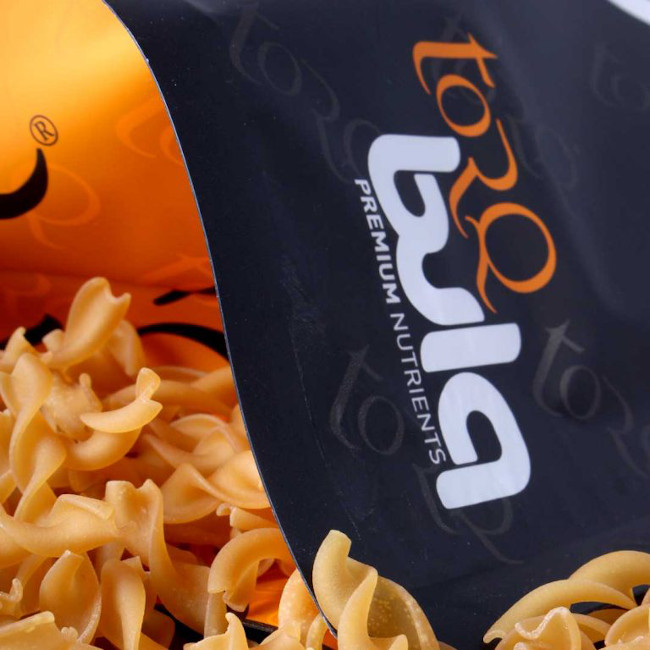
Our pasta looks and cooks like normal fusilli swirls and our orzo looks like and has the texture of rice. Both are equally nutrient-rich. For further information or to purchase TORQ Fusilli, click HERE. For TORQ Orzo, click HERE.
Delicious Protein Recipes: We have taken the time to search the internet for some healthy vegetarian recipes into which our protein fusilli or orzo can be added or exchanged for ‘some’ of the regular pasta or rice (or in the case of the first recipe, couscous) already in the recipe. We’re sure you could find more by searching yourself and apply the principle of swapping carbs for protein, but as well as getting some inspiration from our selections, we have also reverse-engineered the nutritionals on the recipes listed to give you a precise serving size that will deliver the golden 20g and 25g of protein you need.
Recipes Explained: Each recipe can be found at the external link provided in each of the introductions below. These aren’t TORQ’s recipes – they’re recipes created by leading names in the ‘recipe business’ – all we’ve done is adapted them and recalculated the nutritional data to help you in your quest to feed your body the correct amount of protein. The nutritional table for each recipe shows the amount of protein, carbohydrate and fat in each recipe and also a serving size that will deliver precisely 20g or 25g of protein.
You will note that we have suggested simple adaptations to the recipes, which involves swapping out some or all of the rice or pasta within the recipes with TORQ Orzo or TORQ Fusilli. The higher the % of the TORQ ingredients, the higher the protein content and the smaller the serving required to deliver 20g or 25g of protein. This means that like TORQ’s SNAQ Meals, the recipes can be adapted according to your specific needs. For instance, if you are wanting a substantial meal for lunch or dinner, you probably wouldn’t need to add any TORQ ingredients at all, but if you would like a small ‘snack’ serving size mid morning or mid afternoon, the versions of the recipe containing TORQ ingredients will reduce the bulk and overall calories of the meal whilst still delivering the essential 20g-25g of protein required. Where the rice or pasta is swapped out for 100% TORQ ingredients, the serving sizes are very small.
As a suggestion, you could make up a large batch of one of the recipes and weigh out individual portions to put in the freezer knowing that each portion contains 20-25g of protein. Even if you round the weights of the portions up or down to an easy number to work with, you should be able to confidently get it to sit within the 20-25g protein range. Of course, remember that if you really want convenience, take a look at our SNAQ range, which essentially offer the same concept.
BLACK BEAN AND CORN SALAD
This beautiful dish is perfect for hot summer days or as an easy ‘on the go’ meal all year round. The recipe is available from Hurry Up Food and as discussed above, the recipe can be adapted to boost its protein content by swapping out some or all of the couscous for TORQ Orzo.
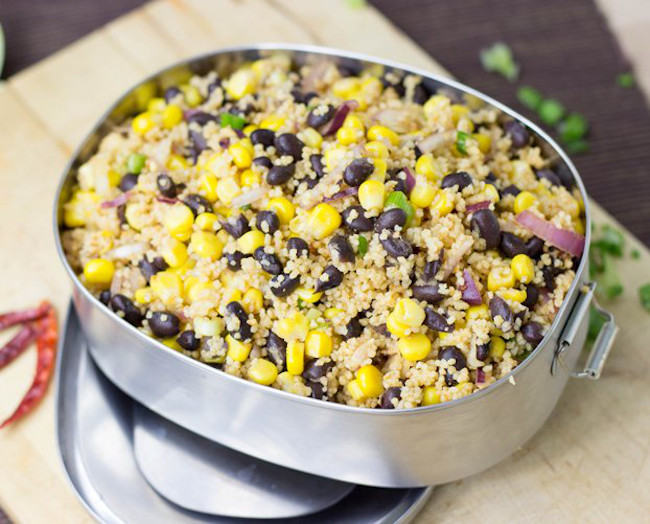
Macronutrient table for the recipe based on the original recipe, 25%, 50% and 100% of TORQ Orzo.
| Fat (g) | Carbohydrate (g) | Protein (g) | Serve (g) for 20g Protein | Serve (g) for 25g Protein | |
|---|---|---|---|---|---|
| No TORQ Orzo | 19.8 | 86.1 | 15.3 | 775 | 968 |
| 25% TORQ Orzo | 19.7 | 81.5 | 20.2 | 585 | 731 |
| 50% TORQ Orzo | 20.1 | 85.7 | 26.6 | 445 | 556 |
| 100% TORQ Orzo | 20.5 | 85.3 | 37.9 | 312 | 390 |
With this recipe, swap Couscous for TORQ Orzo.
SPINACH, SWEET POTATO AND LENTAL DAHL
Perfect for lunch and dinner, a light meal with a high protein content and a tad of spice is one way to reward yourself after a hard training session. From BBC Good Food you can further increase the protein content of this meal by replacing some or all of the red lentils with TORQ Orzo.
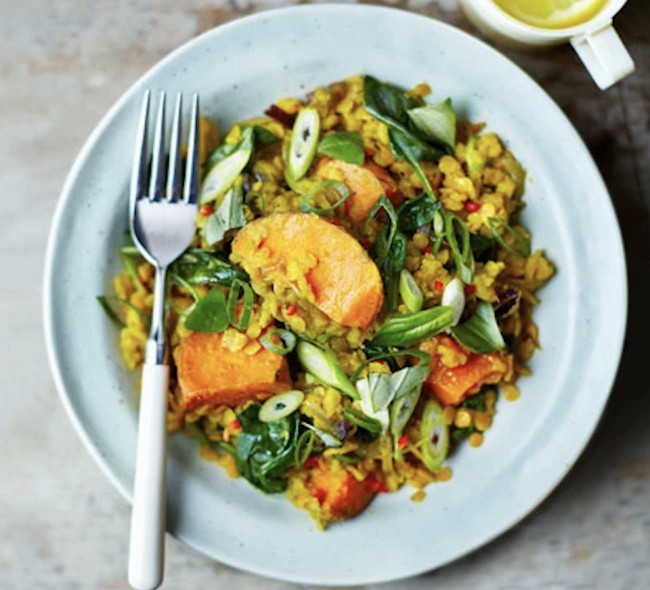
Macronutrient table for the recipe based on the original recipe, 25%, 50% and 100% of TORQ Orzo.
| Fat (g) | Carbohydrate (g) | Protein (g) | Serve (g) for 20g Protein | Serve (g) for 25g Protein | |
|---|---|---|---|---|---|
| No TORQ Orzo | 5.3 | 61.5 | 22.5 | 451 | 564 |
| 25% TORQ Orzo | 5.6 | 55.3 | 17.7 | 365 | 456 |
| 50% TORQ Orzo | 5.7 | 49.1 | 33.0 | 307 | 384 |
| 100% TORQ Orzo | 6.28 | 36.7 | 43.5 | 233 | 291 |
With this recipe, swap Red Lentils for TORQ Orzo.
PASTA SALAD WITH BOCCONCINI, CAPERS AND TOMATOES
With only a few ingredients this recipe from Olive Magazine makes a flavour-rich, fresh meal with plenty of vegetables to support your (at least) 5 a day target. This time, to increase the protein component of this meal you can replace some or all of the standard fusilli with TORQ Fusilli.
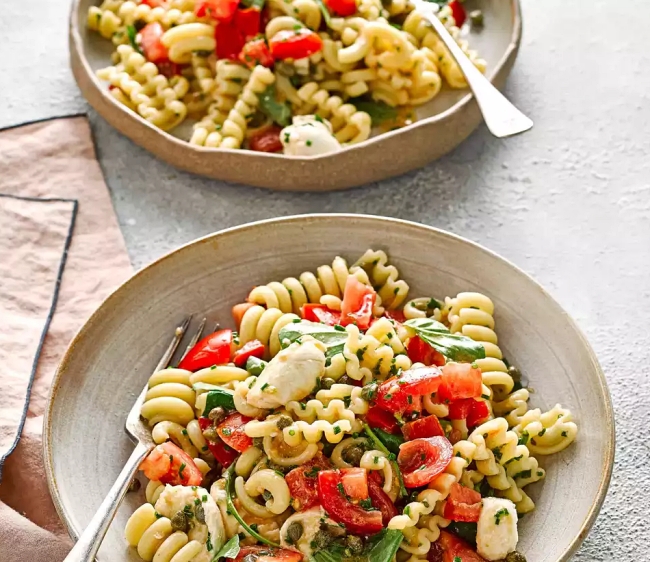
Macronutrient table for the recipe based on the original recipe, 25%, 50% and 100% of TORQ Fusilli.
| Fat (g) | Carbohydrate (g) | Protein (g) | Serve (g) for 20g Protein | Serve (g) for 25g Protein | |
|---|---|---|---|---|---|
| No TORQ Fusilli | 30.7 | 48.3 | 20.56 | 258 | 323 |
| 25% TORQ Fusilli | 31.0 | 19.3 | 31.2 | 170 | 212 |
| 50% TORQ Fusilli | 31.2 | 20.2 | 42 | 126 | 158 |
| 100% TORQ Fusilli | 31.8 | 22 | 63.4 | 83 | 104 |
With this recipe, swap the standard fusilli for TORQ Fusilli.
LAZY SUMMER PASTA SALAD
You can enjoy this light and summery pasta salad from BBC Good Food either hot or cold, which makes it perfect for a snack or a lunch alike. By swapping some or all of the standard fusilli for TORQ Fusilli, you can increase the protein ratio significantly. With 100% TORQ Fusilli, you can achieve 20g of protein in a 70g portion.
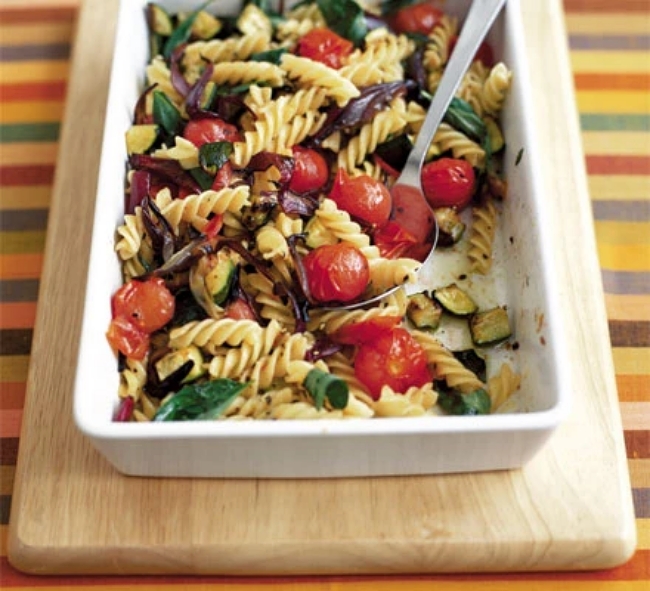
Macronutrient table for the recipe based on the original recipe, 25%, 50% and 100% of TORQ Fusilli.
| Fat (g) | Carbohydrate (g) | Protein (g) | Serve (g) for 20g Protein | Serve (g) for 25g Protein | |
|---|---|---|---|---|---|
| No TORQ Fusilli | 23.1 | 59.8 | 5.87 | 1233 | 1541 |
| 25% TORQ Fusilli | 23.3 | 53.8 | 16.6 | 434 | 543 |
| 50% TORQ Fusilli | 23.6 | 47.8 | 27.3 | 264 | 330 |
| 100% TORQ Fusilli | 24.2 | 35 | 48.8 | 148 | 185 |
With this recipe, swap the standard fusilli for TORQ Fusilli.
TOMATO, & MEDITERRANEAN RISOTTO
A risotto is a fantastic way to carb load before a long endurance event or race, yet this delicious vegetarian recipe from Wallflower Kitchen contains very little protein, which makes swapping some of the risotto rice out for TORQ Orzo essential. The native recipe would require you to eat over 1kg of food to achieve 20g of protein! Note that even swapping 25% of the rice in this recipe for TORQ Orzo will reduce the portion size significantly.
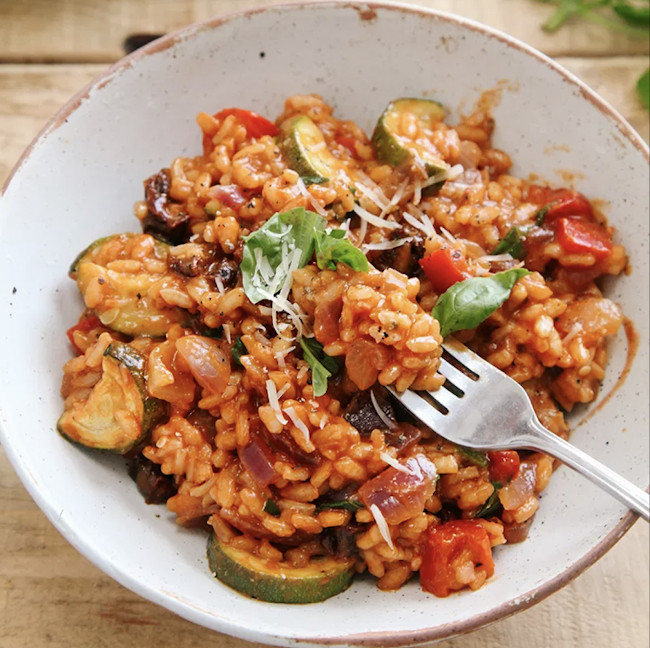
Macronutrient table for the recipe based on the original recipe, 25%, 50% and 100% of TORQ Orzo.
| Fat (g) | Carbohydrate (g) | Protein (g) | Serve (g) for 20g Protein | Serve (g) for 25g Protein | |
|---|---|---|---|---|---|
| No TORQ Orzo | 29.2 | 61.9 | 8.4 | 1052 | 1315 |
| 25% TORQ Orzo | 29.2 | 54.2 | 15.5 | 567 | 709 |
| 50% TORQ Orzo | 28.7 | 46.4 | 22.7 | 388 | 485 |
| 100% TORQ Orzo | 29.4 | 31.1 | 37.1 | 238 | 297 |
With this recipe, swap Risotto Rice for TORQ Orzo.
LEEK LEMON & WHITE BEAN ORZO
Rich in in micronutrients this gorgeous recipe incorporates the delicate flavours of leek and the sharpness of lemon to produce a flavourful and balanced dish. You can find this recipe at Delicious Magazine and can swap-out some or all of the regular orzo in the recipe for TORQ Orzo.
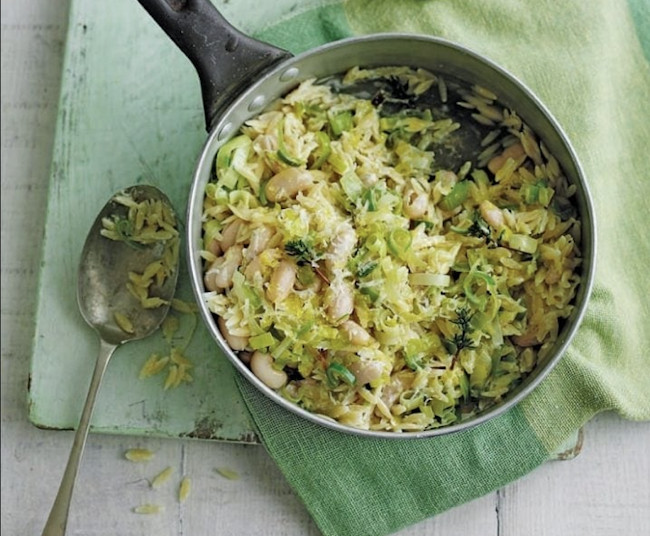
Macronutrient table for the recipe based on the original recipe, 25%, 50% and 100% of TORQ Orzo.
| Fat (g) | Carbohydrate (g) | Protein (g) | Serve (g) for 20g Protein | Serve (g) for 25g Protein | |
|---|---|---|---|---|---|
| No TORQ Orzo | 36.5 | 85.5 | 20.3 | 488 | 560 |
| 25% TORQ Orzo | 36.6 | 71.9 | 30.8 | 295 | 369 |
| 50% TORQ Orzo | 36.7 | 59.7 | 40.6 | 224 | 280 |
| 100% TORQ Orzo | 37 | 33.5 | 61.3 | 148 185 |
With this recipe, swap Regular Orzo for TORQ Orzo.
MIXED BEAN AND RICE BURRITO
High carb and high protein! It’s the perfect post exercise recovery meal after endurance exercise! This recipe from BBC Food combines foods that are naturally rich in carbohydrate and well as forming complete protein with the mixture of pulses and grains. You can enrich the protein profile significantly however by trading some of the long grain rice for TORQ Orzo.
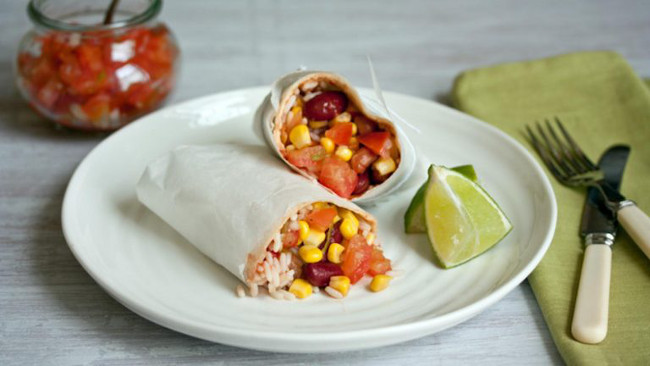
Macronutrient table for the recipe based on the original recipe, 25%, 50% and 100% of TORQ Orzo.
| Fat (g) | Carbohydrate (g) | Protein (g) | Serve (g) for 20g Protein | Serve (g) for 25g Protein | |
|---|---|---|---|---|---|
| No TORQ Orzo | 10.1 | 74.3 | 19.3 | 523 | 654 |
| 25% TORQ Orzo | 10.3 | 68.9 | 24.1 | 412 | 515 |
| 50% TORQ Orzo | 10.6 | 63.6 | 29.1 | 319 | 399 |
| 100% TORQ Orzo | 11.3 | 52.8 | 39.6 | 251 | 314 |
With this recipe, swap Long Grain Rice for TORQ Orzo.
Summary: Protein plays an essential role of controlling and regulating how the human body functions on a day-to-day basis, but also how we adapt and repair from both endurance and resistance/strength exercise. If you are consuming a healthy balanced diet, although you may not be under consuming on protein, perhaps you could improve upon the timing, type and quality of the protein source that you choose to consume. Providing a frequent and consistent supply of protein and amino acids every 3-4 hours from the diet maintains a positive protein balance, enhancing recovery and promoting positive training adaptations.
If you have any questions relating to this article, please don’t hesitate in contacting us at enquiries@torqfitness.co.uk or by phone 0344 332 0852.
References:
Brown, E.C., DiSilvestro, R.A., Babaknia, A. and Devor, S.T., 2004. Soy versus whey protein bars: effects on exercise training impact on lean body mass and antioxidant status. Nutrition Journal, 3(1), p.22.
Foster, C.D.L.C., Costill, D.L. and Fink, W.J., 1979. Effects of preexercise feedings on endurance performance. Medicine and science in sports, 11(1), pp.1-5.
Gibala, M.J., 2007. Protein metabolism and endurance exercise. Sports Medicine, 37(4-5), pp.337-340.
Howarth, K.R., Moreau, N.A., Phillips, S.M. and Gibala, M.J., 2009. Coingestion of protein with carbohydrate during recovery from endurance exercise stimulates skeletal muscle protein synthesis in humans. Journal of Applied Physiology.
Ivy, J.L., Sprague, R.C. and Widzer, M.O., 2003. Effect of a carbohydrate-protein supplement on endurance performance during exercise of varying intensity. International journal of sport nutrition and exercise metabolism, 13(3), pp.382-395.
Jackman, S.R., Witard, O.C., Philp, A., Wallis, G.A., Baar, K. and Tipton, K.D., 2017. Branched-chain amino acid ingestion stimulates muscle myofibrillar protein synthesis following resistance exercise in humans. Frontiers in physiology, 8, p.390.
Kalman, D.S., 2014. Amino acid composition of an organic brown rice protein concentrate and isolate compared to soy and whey concentrates and isolates. Foods, 3(3), pp.394-402.
Komindr, S., INGSRISWANG, S. and Boontawee, A., 2001. Protein Conservation in Type 2 Diabetic Patients. J Med Assoc Thai, 84, pp.85-97.
Lemon, P.W. and Proctor, D.N., 1991. Protein intake and athletic performance. Sports Medicine, 12(5), pp.313-325.
Madzima, T.A., Melanson, J.T., Black, J.R. and Nepocatych, S., 2018. Pre-sleep consumption of casein and whey protein: Effects on morning metabolism and resistance exercise performance in active women. Nutrients, 10(9), p.1273.
Miraghajani, M.S., Najafabadi, M.M., Surkan, P.J., Esmaillzadeh, A., Mirlohi, M. and Azadbakht, L., 2013. Soy milk consumption and blood pressure among type 2 diabetic patients with nephropathy. Journal of Renal Nutrition, 23(4), pp.277-282.
Ogasawara, R., Kobayashi, K., Tsutaki, A., Lee, K., Abe, T., Fujita, S., Nakazato, K. and Ishii, N., 2013. mTOR signaling response to resistance exercise is altered by chronic resistance training and detraining in skeletal muscle. Journal of applied physiology, 114(7), pp.934-940.
Rowlands, D.S., Thorp, R.M., Rossler, K., Graham, D.F. and Rockell, M.J., 2007. Effect of protein-rich feeding on recovery after intense exercise. International journal of sport nutrition and exercise metabolism, 17(6), pp.521-543.
Saunders, M.J., 2007. Coingestion of carbohydrate-protein during endurance exercise: influence on performance and recovery. International Journal of Sport Nutrition and Exercise Metabolism, 17(s1), pp.S87-S103.
Wang, X. and Proud, C.G., 2006. The mTOR pathway in the control of protein synthesis. Physiology, 21(5), pp.362-369.
